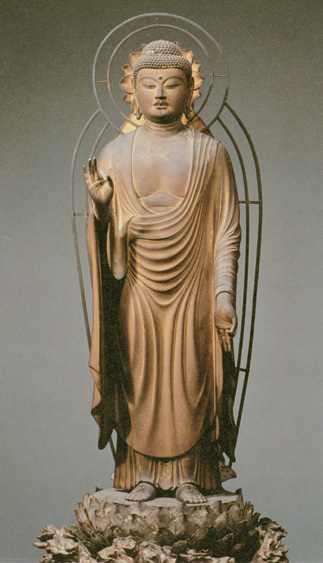An Illustrated Outline of Buddhism: The Essentials of Buddhist Spirituality (21 page)
Read An Illustrated Outline of Buddhism: The Essentials of Buddhist Spirituality Online
Authors: William Stoddart,Joseph A. Fitzgerald
Tags: #Philosophy

It is told that once Ānanda, the beloved disciple of the Buddha,
saluted his master and said:
“
Half of the holy life, O master, is
friendship with the beautiful, association with the beautiful,
communion with the beautiful.
”
“
Say not so, Ānanda, say not so!
”
the master replied.
“
It is
not half the holy life, it is the whole of the holy life.
”
Samyutta-Nikāya


65
(12) The Seven Patriarchs of the Pure Land
School of Mahayana Buddhism
The doctrine and practice of the Pure Land school of
Mahāyāna
Buddhism (Sanskrit
Sukhāvatī
;
Chinese
Ching-t’u
;
Japanese
Jōdo
)
are founded on the Buddha’s “Original Vow”. Essential y it is a ques-
tion of total reliance on the saving power of the Name of the Buddha
Amitābha
(Amida). See pp. 79-80.
The Japanese names of the Chinese patriarchs are given within
square brackets.
Nāgārjuna*
(2nd century A.D.)
Indian
Vasubandhu*
(4th century A.D.)
T’an-Luan [Donran]
(476-542 A.D.)
T’ao-Ch’o* [Doshaku]
(561-644 A.D.)
Chinese
Shan-Tao [Zendo]
(613-681 A.D.)
Genshin
(942-1017 A.D.)
Japanese
Hōnen*
(1133-1212 A.D.)
Other eminent Japanese representatives of the
Jōdo
school—not
however counted amongst the patriarchs—were Kūya (903-972) and
Ryōnin (1072-1132). A prominent disciple of Hōnen was Shōnin Shin-
ran* (1173-1262), founder of the
Jōdo-shin
school.
*
See index for further references to these personages
Whoever has faith in Me and love for Me is assured of rebirth
in Heaven.
The Buddha
(
Majjhima-Nikāya
, i,142)


66
An Illustrated Outline of Buddhism
Amida Buddha, Japan, 1202-1208
Fools of poor understanding have themselves for their greatest
enemies, for they do evil deeds which bear bitter fruits.
Dhammapada, 66


67
(13) Buddhas and Bodhisattvas
Etymological y,
buddha
means “enlightened”, and
bodhisattva
means
“one whose nature is enlightenment”. In
Mahāyāna
Buddhism, the term
bodhisattva
has been traditional y understood to mean an “aspirant for
Buddhahood”—one who seeks Buddhahood through the transcending
of the five “attributes of individuality” (
skandha
s)
and the acquiring of
the six virtues (
pāramitā
s).
(See pp. 39 and 77 respectively.)
The Bodhisattva
is
also said to be “one who renounces final entry
into
Nirvāna
until all beings are saved”, and in this connection, the ele-
ment compassion (
karunā
) is
foremost. This formulation is no doubt
operative in intention, but it is nevertheless paradoxical in form, as it
can scarcely be that a Bodhisattva
needs to stop short of
Nirvāna
in
order to be able to save others.
Let us observe parenthetical y that the
Dhammapada
(159 and
166) makes it clear that man’s first duty is to save his soul. This is the
very opposite of being “selfish”! To escape from the clutches of
samsāra
is
the greatest possible service that one can render to others. This is
true in the case of ordinary morality as well as in the case of contem-
plative monasticism: the
Dhammapada
(54)
states: “The perfume of
virtue travels against the wind and reaches unto the ends of the earth.”
The merciful function envisaged by the
Mahāyāna
doctrine is the
salvation of believers by the bestowal upon them of the merit of the
Bodhisattva.
In other words, it means the redemption of creatures,
hopelessly afflicted with ignorance and suffering, by the saving power
of Another. This is precisely the role of the Bodhisattva.
(See “The Bo-
dhisattva’s
Undertaking” on p. 70 and “Dharmākara’s
Vow”
on p. 79.) The saving compassion of the Bodhisattva
is
contrasted with the
condition of the
pratyeka-buddha
,
who is a “solitary” who achieves
enlightenment without possessing the function or mission of commu-
nicating it to others. On the contrary, the Bodhisattva
possesses the
state of the
samyaksam-buddha
, whose providential y ordained cosmic
wisdom endows him with the ability—and the mission—to transmit
the saving message and the saving grace to the world.
Mahāyāna
Buddhism teaches that there are two kinds of Bodhisat-
tvas: terrestrial and celestial. Terrestrial Bodhisattvas are characterized
by their compassion, manifested chiefly by their thrust towards salva-
tion or enlightenment (for themselves and others). Celestial Bodhi-
sattvas have actualized the six
pāramitā
s,
possess buddhahood, and,
while not being subject to
samsāra
,
are nevertheless present within it
for the salvation of men. In the
Mahāyāna
perspective, compassion

68
An Illustrated Outline of Buddhism
is seen as a dimension of knowledge, and the Bodhisattva
is the very
incarnation of this.
Amongst the many celestial Bodhisattvas
are Avalokiteshvara
(the
Bodhisattva
of Mercy), Mahāsthāmaprāpta
(the one who awakens men
to the need for salvation), Mañjushrī
(the Bodhisattva
of Wisdom),
Kshitigarbha—in Japan Jizō—(the savior from hell and the protector
of children and travelers), and Achala Vidyārāja—in Japan Fudō—(the
opponent of the world’s inequities, stupor, and indifference to truth).
The feminine aspect of Avalokiteshvara, known in China as Kwan-
Yin and in Japan as Kwannon, is particularly venerated in these two
countries. Kwan-Yin is often assimilated to Tārā, who is venerated in
Tibet as the Consort of Avalokiteshvara (see p. 89).
A
Buddha
can be said to be one who has come from Heaven to
earth in order to reveal the path that leads from earth to Heaven (i.e. the
achieving of
Nirvāna
from the starting-point of
samsāra
—the achiev-
ing of the Absolute from the starting-point of the relative). A
Bodhisat-
tva,
for his part, is a helping, compassionate, salvific, and Nirvanic
presence within
samsāra
itself. His role may be compared to the Christian
doctrine of the Holy Spirit as an ever-present Helper in this world.
In a certain sense, it could be said that the grace of the Buddha
is static or intrinsic, and the grace of the Bodhisattva dynamic or ex-
